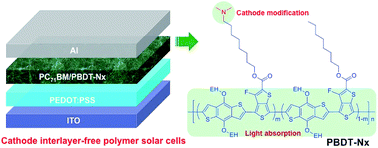Bifunctional donor polymers bearing amino pendant groups for efficient cathode interlayer-free polymer solar cells†
Abstract
Conjugated polymers with amino pendants are usually used as cathode interlayer (CIL) materials in polymer solar cells (PSCs), but show no photovoltaic responses when being a photoactive component in the active layer because of the hole trapping effect of amino groups. In this work, we re-examine this viewpoint by developing a new series of amino-functionalized conjugated polymers PBDT-Nx, which can be used as a bifunctional donor material for light harvesting and cathode modification at the same time, exhibiting remarkable photovoltaic behaviors in CIL-free PSCs. This is enabled by rationally manipulating the relative positions between the HOMO level of these polymers and the ionization state of the amino group to minimize the hole trapping process, and regulating the amino content and distribution in the active layer. A decent PCE of over 5% has been achieved from these amino-containing polymers, which is so far the highest value for CIL-free PSCs. This work demonstrates that in addition to being CIL materials the amino-based conjugated polymers also qualify as efficient photovoltaic materials for simplified device architecture and reduced material and processing costs.



 Please wait while we load your content...
Please wait while we load your content...